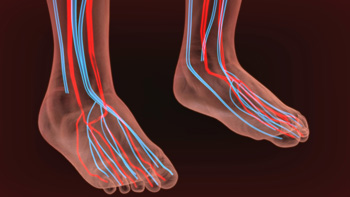
Lansdowne, PA
(610) 626-3338

Lansdowne, PA
(610) 626-3338
 Peripheral artery diseas, commonly known as PAD, is a condition that causes poor circulation to the lower limbs. PAD in the legs and lower extremities is the narrowing or blockage of the vessels that carry blood from the heart to the legs. This is caused by a buildup of fatty plaque in the arteries, which leads to the arteries hardening and constricting. Several risk factors can increase your chances of developing PAD, which include being a smoker, having high blood pressure, atherosclerosis, diabetes, high cholesterol, and being over the age of 60. Both men and women can develop PAD. For more information about peripheral artery disease and to get tested, please speak with a podiatrist today.
Peripheral artery diseas, commonly known as PAD, is a condition that causes poor circulation to the lower limbs. PAD in the legs and lower extremities is the narrowing or blockage of the vessels that carry blood from the heart to the legs. This is caused by a buildup of fatty plaque in the arteries, which leads to the arteries hardening and constricting. Several risk factors can increase your chances of developing PAD, which include being a smoker, having high blood pressure, atherosclerosis, diabetes, high cholesterol, and being over the age of 60. Both men and women can develop PAD. For more information about peripheral artery disease and to get tested, please speak with a podiatrist today.
Peripheral artery disease can pose a serious risk to your health. It can increase the risk of stroke and heart attack. If you have symptoms of peripheral artery disease, consult with Dr. George Yarnell from Pennsylvania. Our doctor will assess your condition and provide you with quality foot and ankle treatment.
Peripheral artery disease (PAD) is when arteries are constricted due to plaque (fatty deposits) build-up. This results in less blood flow to the legs and other extremities. The main cause of PAD is atherosclerosis, in which plaque builds up in the arteries.
Symptoms
Symptoms of PAD include:
It is important to note that a majority of individuals never show any symptoms of PAD.
Diagnosis
While PAD occurs in the legs and arteries, Podiatrists can diagnose PAD. Podiatrists utilize a test called an ankle-brachial index (ABI). An ABI test compares blood pressure in your arm to you ankle to see if any abnormality occurs. Ultrasound and imaging devices may also be used.
Treatment
Fortunately, lifestyle changes such as maintaining a healthy diet, exercising, managing cholesterol and blood sugar levels, and quitting smoking, can all treat PAD. Medications that prevent clots from occurring can be prescribed. Finally, in some cases, surgery may be recommended.
If you have any questions, please feel free to contact our office located in Lansdowne, PA . We offer the newest diagnostic and treatment technologies for all your foot care needs.